The Fed Just Kicked the Door Open for Smaller Stocks |
Money & Markets Daily,
The rate cut we’ve been waiting for is finally here.
The Federal Open Markets Committee (FOMC) decided to cut its benchmark interest rate by a more aggressive 50 basis points during its two-day meeting, which concluded yesterday.
Now that we know what the Fed will do, the script reverses to those anxious investors wondering what’s next.
Good news… data points us in a solid direction after one of the largest rate-hike cycles in recent memory.
And the answer to what's next might surprise you.
If nothing else, it does point savvy investors in the direction of what they should do now that the Fed has started to reverse course.
Let me explain…
Rate Cooling Has Propped Up This Stock Class
Before the FOMC approved its rate cut on Wednesday, interest rates were already starting to cool.
That’s been reflected in a particular class of stocks in the market.
And it’s not the same high-growth tech stocks that drove the market rally earlier this year.
It’s small- and mid-cap stocks.
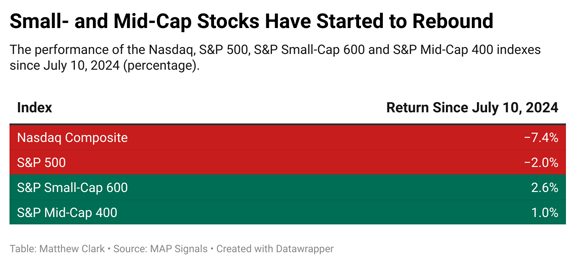
In the last two months, the S&P Small-Cap 600 index has gained 2.6%, while the S&P Mid-Cap 400 index is up 1%.
On the other hand, the tech-heavy Nasdaq Composite is down 7.4%, and the S&P 500 is off 2%.
Here’s further proof of the correlation between interest rates and small-cap stock performance:
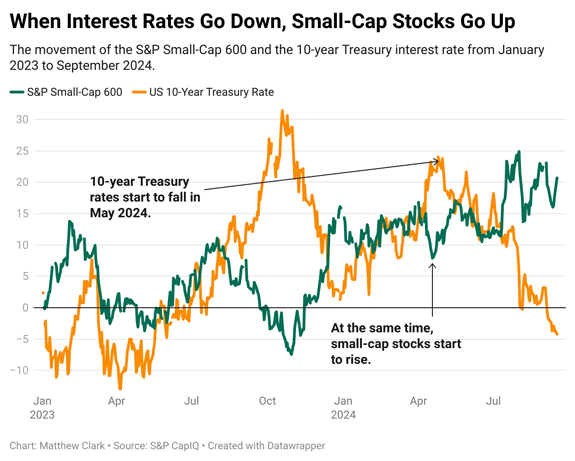
When Treasury interest rates (yellow line) reached a peak in October 2023, the S&P Small-Cap 600 index (green line) hit its lowest point since January 2023.
You can also see that when those interest rates start to come down, small-cap stocks rise.
Considering that macro view, let's examine how small caps react in more favorable market environments.
Small-Cap Fundamentals Improve With Lower Rates
In general, when stock prices go up, earnings go up.
Because the market looks at least 12 months into the future, consensus earnings-per-share growth is important to analyze.
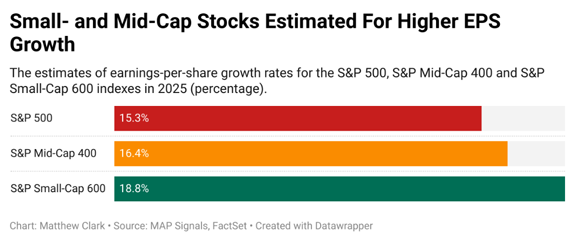
Estimates suggest that small- and mid-cap stocks have stronger earnings growth than the broader S&P 500.
And these higher estimates are tied directly to lower interest rates.
Smaller companies typically carry more debt than their large-cap counterparts. That debt is expensive to service … especially when interest rates are high.
Lowering interest rates drops the cost of that debt for small companies and helps their bottom line.
To show how well a business can pay interest on outstanding debt, we can look at its interest coverage — or earnings before interest and taxes divided by interest expense. The lower the interest coverage, the “harder” it is for a company to pay interest on debt:
- S&P 500 — 7.8x.
- S&P Mid-Cap 400 — 3.8x.
- S&P Small-Cap 600 — 2.3x.
Small- and mid-cap companies have more debt and less capital to pay it.
But when interest rates fall, those multiples get better because the interest expense is lower.
This is a signal for investors to look closer at small- and mid-cap stocks as rates fall. Their interest coverage gets better along with their earnings, resulting in an overall significantly stronger bottom line.
Want more proof?
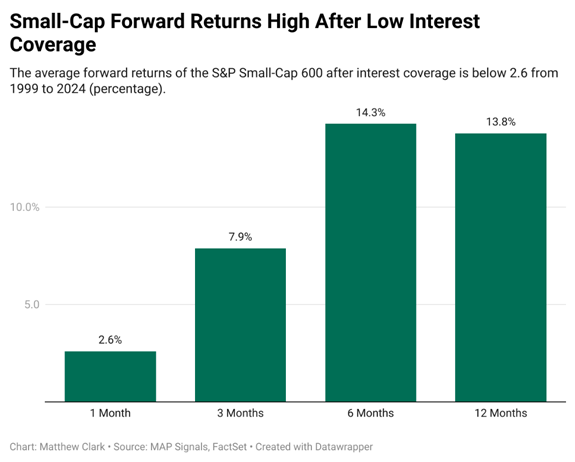
Since 1999, small-cap stocks have experienced gains after their interest coverage hit below 2.6 — it’s at 2.3 currently.
Six months after the interest coverage reached 2.6, small-cap stocks have gained an average of 14.3%.
So, lower rates increase interest coverage and, thus, build up stock performance.
The results are similar for mid-cap stocks:
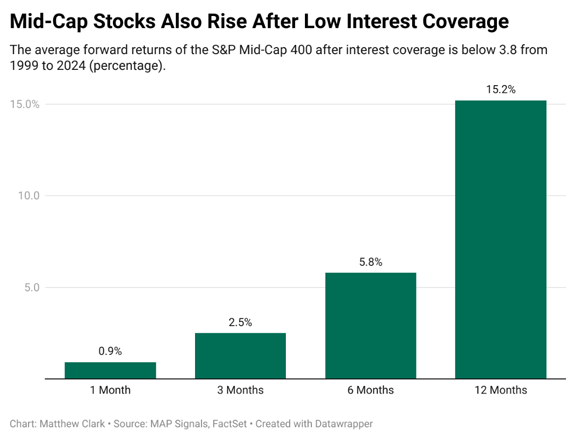
It may take a little longer, but mid-cap stocks have also experienced double-digit growth after interest coverage went below 3.8x.
Similar to small caps, when interest rates drop, interest coverage for mid caps goes up along with the stock price.
What It All Means: With interest rate cuts now in motion, small- and mid-cap stocks are poised to benefit in a big way.
History shows these two classes of stocks reach double-digit share price growth between 6 and 12 months after reaching a low.
The recent action by the FOMC could kick the door open to provide big gains for these stocks now … and in the immediate future.
Until next time…
Safe trading,

Matt Clark, CMSA®
Chief Research Analyst, Money & Markets Daily
Check Out More From Money & Markets Daily:

Tidak ada komentar:
Posting Komentar